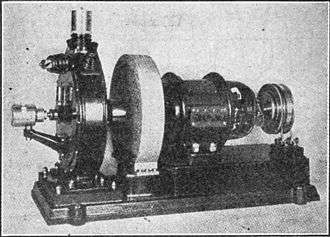Rudolf Goldschmidt
Rudolf Goldschmidt (March 19, 1876, Neubukow, Mecklenburg – 1950, London) was a German engineer and inventor.
Goldschmidt was born in Neubukow and earned an engineering degree in 1898. He spent the following decade working in England with major firms such as Westinghouse. Subsequently he returned to Germany and eventually became a professor at Darmstadt.
In 1908 he developed a rotating radio-frequency machine, the Goldschmidt alternator, which was used as an early radio transmitter. This was manufactured by German firm Hochfrequenz-Maschinen Aktiengesellschaft für Drahtlose Telegraphie, and used in high power longwave radio stations to transmit intercontinental radiotelegraph traffic. Large 100 kilowatt Goldschmidt transmitters in Eilvese, Germany and Tuckerton, New Jersey, USA were used in the first direct communications link between Germany and the United States, which was inaugurated on June 19, 1914 with a ceremonial exchange of telegrams between Kaiser Wilhelm II and President Woodrow Wilson. Alternator radio transmitters were used into the 1920s, when they were replaced by vacuum tube transmitters. As one of the first continuous wave transmitters, the Goldschmidt alternator was able to transmit audio (sound) as well as telegraphy signals, and was used for some early experimental AM radio transmissions.

He also invented a mechanical device, the Goldschmidt tone wheel, used in early radio receivers to receive the new continuous wave radiotelegraph signals. The first radio transmitter, the spark-gap transmitter, produced a string of damped waves that sounded like a buzz or tone in a radio receiver, so the pulses of radio waves used to transmit Morse code were audible as "beeps" in the receiver. However, the new transmitters like the Goldschmidt alternator generated unmodulated continuous waves, which were inaudible in receivers. To make them audible, the tone wheel receiver used the heterodyne principle to convert the radio frequency to an audio frequency. The tone wheel was a disk with contacts around the rim, spun by a small electric motor, which interrupted the incoming radio signal at a radio frequency rate. The tone wheel acted as a crude beat frequency oscillator (BFO), introducing a second radio frequency which combined with the received signal to create a "beat" (heterodyne) frequency at the difference of the two frequencies, in the audio range. For example, if the frequency of the received signal was 60,000 Hz, the tone wheel could be adjusted to introduce a frequency of 59,000 Hz, creating a 1,000 Hz tone which could be heard in the earphones as a musical "beep" whenever the carrier was present.
The tone wheel was used for a short period until the 1920s when it was replaced by the vacuum tube regenerative receiver. Later the tone wheel was used as a musical tone generating device in early electronic organs.
During the 1920s, Goldschmidt directed an industrial research lab in Berlin. Here he met Albert Einstein. In 1928, a singer with whom the physicist was acquainted suffered a hearing loss, which misfortune set Einstein to thinking about hearing aids. Soon he had an idea and asked Goldschmidt to help him develop a working model. In due course a patent was issued to Goldschmidt and Einstein on January 10, 1934.
In 1934, Goldschmidt emigrated to England. He kept up his correspondence with Einstein until his death in Bournemouth in 1950.
References
- Pais, Abraham (2005). Subtle is the Lord. Oxford: Oxford University Press. ISBN 0-19-280672-6. Appendix: Einstein's collaborators